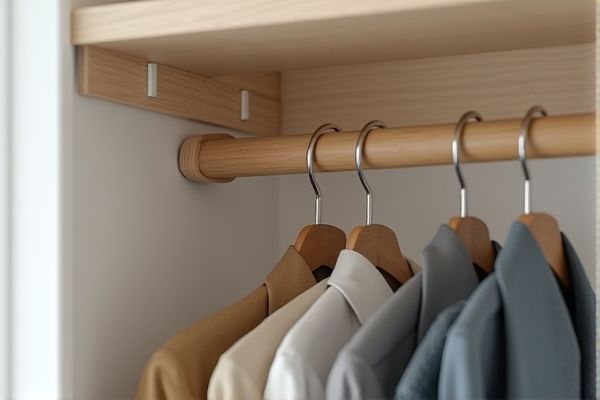
Closet hooks offer versatile and sturdy storage solutions for hanging heavier items like coats and bags, while pegs typically provide simpler, space-saving options ideal for lighter accessories. Explore this article to discover which option best suits Your organizational needs and closet space.
Table of Comparison
| Feature | Closet Hook | Peg |
|---|---|---|
| Use | Hanging clothes, bags, accessories | Hanging hats, coats, keys, light items |
| Design | Curved or angled metal/plastic hook | Simple cylindrical or tapered peg |
| Installation | Mounted on walls or inside closets | Mounted on walls, boards, or racks |
| Weight Capacity | Medium to high, depends on material | Low to medium, better for lighter items |
| Space Efficiency | Ideal for maximizing closet space | Good for entryways or decorative use |
| Material | Metal, plastic, wood | Wood, metal, plastic |
| Common Applications | Closet organizers, wardrobe systems | Hallway coat racks, multipurpose hooks |
Introduction: Closet Hook vs Peg
Closet hooks and pegs both serve as essential storage solutions for organizing clothing and accessories, but they differ in design and functionality. Closet hooks typically feature a curved shape ideal for hanging coats, hats, or bags securely, while pegs are usually cylindrical or rounded, providing versatile attachment points for lighter items or multiple hangings. Choosing between a closet hook and peg depends on the specific storage needs, weight capacity, and aesthetic preferences within the closet space.
Overview of Closet Hooks
Closet hooks provide a practical solution for organizing items like bags, scarves, or lightweight clothing, typically featuring a curved design for easy hanging. Pegs, on the other hand, are sturdier, often used for heavier garments or accessories, and can be mounted individually or in rows on closet walls. Understanding the specific use and weight capacity of closet hooks versus pegs helps you optimize your storage space efficiently.
Overview of Pegs
Closet pegs are small, cylindrical fixtures typically made of wood, plastic, or metal, designed to hold items such as hats, bags, or coats securely on walls or inside closets. Unlike hooks that often have a curved or angled shape, pegs provide a simple, straight projection that supports hanging items without slipping. Their minimalistic design makes pegs an efficient, space-saving solution for organizing closets and maximizing storage capacity.
Material Differences
Closet hooks are typically made from metal or heavy-duty plastic, offering durability and a sleek finish, while pegs are often crafted from wood or simple plastic, prioritizing ease of installation and a rustic look. Metal hooks resist bending and provide stronger support for heavy items such as coats or bags, whereas wooden pegs may absorb moisture and wear over time but add natural warmth to your closet. Knowing these material differences helps you choose the best option that balances function and style for your storage needs.
Installation and Setup
Closet hooks typically require screws or nails for secure installation into wall studs or wooden surfaces, ensuring a stable hold for heavier items, while pegs often fit into pre-drilled holes or pegboards, offering a simpler, tool-free setup. Your choice between a hook and peg may depend on the wall material and the weight of items you plan to hang. Hooks provide more robust support but need precise placement, whereas pegs offer easy repositioning and flexible organization.
Space Efficiency
Closet hooks maximize space efficiency by offering compact, wall-mounted storage solutions that keep items organized without protruding significantly into the room. Pegs provide a versatile option, allowing for flexible placement and easy rearrangement to optimize vertical space in small closets. Both enhance closet utility, but hooks often allow for hanging bulkier items while pegs suit lighter, more frequently accessed accessories.
Weight Capacity Comparison
Closet hooks typically offer a higher weight capacity than pegs, often supporting up to 15-20 pounds per hook due to their robust design and mounting style. Pegs, while space-efficient and stylish, usually support lighter loads, around 5-10 pounds, making them better suited for smaller items like hats or scarves. To ensure your storage solution meets your needs, consider the weight capacity relative to what you plan to hang in your closet.
Aesthetics and Design Options
Closet hooks offer sleek, minimalist designs that blend seamlessly into modern interiors, often crafted from metal or plastic with smooth finishes. Pegs provide more rustic or traditional aesthetics, available in various shapes and natural wood tones that add warmth and character to a space. Both options enhance closet organization but differ significantly in style versatility and visual impact.
Best Use Cases for Hooks and Pegs
Closet hooks are ideal for hanging items like bags, hats, and scarves, providing easy access and helping maximize vertical space. Pegs, often smaller and more spaced out, work best for lightweight accessories such as belts, ties, or jewelry, keeping your closet organized without overcrowding. Your choice between hooks and pegs should depend on the size and type of items you need to store for efficient use.
Conclusion: Choosing the Right Option
Closet hooks offer versatile attachment points ideal for hanging items like bags and belts, while pegs provide a fixed, sturdy solution suited for coats and hats. Selecting the right option depends on your storage needs, available space, and the weight of items you intend to hang. For customizable organization, hooks enhance flexibility; for simplicity and durability, pegs remain a reliable choice.
 homyna.com
homyna.com